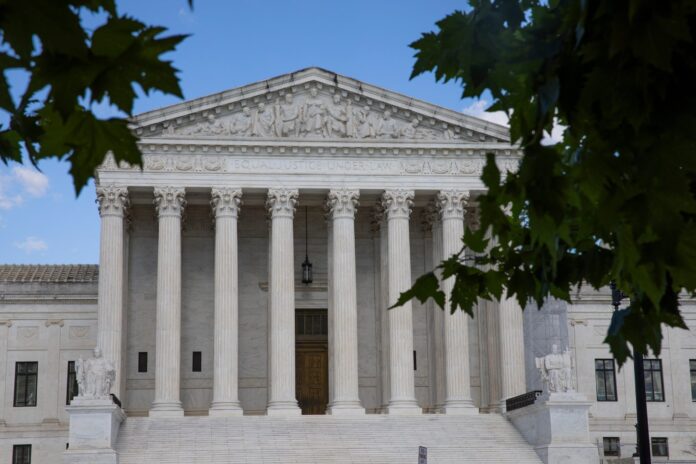Immigration Matters is a recurring series by César Cuauhtémoc GarcÃa Hernández that analyzes the court’s immigration docket, highlighting emerging legal questions about new policy and enforcement practices.
Please note that the views of outside contributors do not reflect the official opinions of SCOTUSblog or its staff.
Kilmar Ãbrego GarcÃa, the citizen of El Salvador who has been made famous by the Trump administration’s efforts to deport him, is fighting hard to remain in the United States – and, perhaps surprisingly, he has the Supreme Court to thank for it. Ãbrego GarcÃa, who is currently being held in an Immigration and Customs Enforcement detention center, is testing the Trump administration’s commitment to seeing him gone permanently from the United States. But the remarkably complex legal contest currently playing out would not have been possible had the justices not ordered federal officials to address his wrongful deportation.
International attention first turned to Ãbrego GarcÃa in the spring, when ICE deported him to El Salvador and officials there detained him in a high-security prison reserved for gang members. Within days of his deportation in March, it became clear that the government had made a mistake. This was because an immigration judge in Baltimore had barred his removal to El Salvador in 2019 due to fear that he would be persecuted upon arrival. That order was still valid six years later. A Justice Department lawyer, Erez Reuveni, told U.S. District Judge Paula Xinis, the judge presiding over Ãbrego GarcÃa’s lawsuit demanding to be returned to the United States, that Ãbrego GarcÃa “should not have been removed to El Salvador.†Shortly thereafter, Attorney General Pam Bondi suspended, then fired, Reuveni, a longtime attorney at the Department of Justice.
Certain that his deportation was illegal, Xinis ordered the administration to “facilitate and effectuate†Ãbrego GarcÃa’s return to the United States. The U.S. Court of Appeals for the 4th Circuit affirmed her order.
In a unanimous decision, the Supreme Court agreed in April that federal officials needed to step up their efforts to fix the error of sending Ãbrego GarcÃa to El Salvador. In a short, two-page order, the court rejected the government’s request to invalidate Xinis’ decision. The court explained that Xinis was correct to require the Departments of State and Homeland Security to facilitate Ãbrego GarcÃa’s release from the prison in El Salvador and “ensure that his case is handled as it would have been had he not been improperly sent†there. (At the same time, the court stated that the term “effectuate†was unclear in the district court’s order, and Xinis should clarify this “directive.â€)
It took almost two months from the date of the Supreme Court’s order, but eventually Ãbrego GarcÃa returned to the United States in June. Though it remains unclear who brought him back or how, U.S. officials immediately took Ãbrego GarcÃa to Tennessee to face criminal prosecution for transporting unauthorized migrants, charges stemming from a 2022 traffic stop. Last month, he was released from federal custody in Tennessee and immediately reunited with his family in Maryland. But then, ICE detained him less than three days later during an appointment at the agency’s Baltimore office.
Ãbrego GarcÃa’s journey through a series of prisons in El Salvador and the United States is highly unusual. Few migrants receive the personal attention of high-level officials that Ãbrego GarcÃa has experienced. During a White House meeting in April with President Donald Trump, El Salvador’s President Nayib Bukele said it was “preposterous†to ask if his government would return Ãbrego GarcÃa to the United States. More recently, Trump described Ãbrego GarcÃa as an “animal,†and Secretary of Homeland Security Kristi Noem claimed, without disclosing supporting evidence, that he is a “child predator.†Ãbrego GarcÃa has never been convicted of any crime.
Ãbrego GarcÃa is currently waging three legal fights in the United States. In Tennessee, he is defending himself against the federal government’s criminal allegations. He argues that the government is trying “to punish him for having the audacity to fight back, rather than accept a brutal injustice.†The case is ongoing, but U.S. Magistrate Judge Barbara D. Holmes granted Ãbrego GarcÃa’s request for release from custody last month.
In Maryland, Ãbrego GarcÃa has asked Xinis to stop ICE from removing him to Uganda, which government officials now say has agreed to accept him. He argues that U.S. government officials cannot remove him because they gave him permission to enter the United States in June through a decades-old legal authority called parole. He also claims that sending him to Uganda violates the immigration judge’s 2019 order barring his return to El Salvador because Uganda has not made any assurances that it will not send him there. Last week, Xinis informed Drew Ensign, the Justice Department lawyer representing the government, that Ãbrego GarcÃa must remain in the United States at least until an Oct. 6 hearing, when she plans to consider and then rule on Ãbrego GarcÃa’s arguments.
In addition to those two cases playing out in federal courts, Ãbrego GarcÃa has resumed his bid for asylum. Federal law gives migrants who fear for their lives one year to apply for asylum. Ãbrego GarcÃa first entered the United States in 2011 or 2012 but did not request asylum until 2019, far past the one-year deadline. Immigration Judge David M. Jones, who considered Ãbrego GarcÃa’s claim at the time, denied the asylum request because Ãbrego GarcÃa did not meet an exception to the one-year filing requirement. Jones, however, concluded that Ãbrego GarcÃa would probably be persecuted by members of a criminal gang if returned to El Salvador and granted him a narrower form of relief from deportation, called withholding of removal. Under Jones’ withholding of removal decision, Ãbrego GarcÃa lived and worked in the United States lawfully until ICE detained him in March.
By requesting asylum now, less than three months after reentering the United States, Ãbrego GarcÃa hopes to avoid the one-year deadline that ended his earlier asylum bid. Whatever the outcome, the asylum application process is complicated. With almost 4 million cases currently pending in the immigration court system, it is likely to take many months, if not years, before an immigration judge reaches a final decision.
All that said, the extraordinary legal effort that Ãbrego GarcÃa has mounted against the federal government would not have been possible without the Supreme Court’s intervention in April. Since being brought back to the United States under pressure from a unanimous court, Ãbrego GarcÃa’s attorneys have pushed government officials to treat their client as if he had not previously been deported. The legal claims they have raised have already slowed the government’s efforts to deport Ãbrego GarcÃa a second time.
It is too early to know whether Ãbrego GarcÃa will be allowed to remain in the United States. All that is clear at this point is that Ãbrego GarcÃa’s wrongful deportation was not the final chapter of his life in the United States. Courts “should continue to ensure that the Government lives up to its obligations to follow the law,†Justice Sonia Sotomayor wrote in a statement joined by Justices Elena Kagan and Ketanji Brown Jackson in Ãbrego GarcÃa’s case. That is exactly what is happening.
Cases: Noem v. Abrego Garcia
Recommended Citation:
César Cuauhtémoc GarcÃa Hernández,
Supreme Court win set up Salvadoran’s fight to remain in U.S.,
SCOTUSblog (Sep. 4, 2025, 10:45 AM),
https://www.scotusblog.com/2025/09/supreme-court-win-set-up-salvadorans-fight-to-remain-in-u-s/





